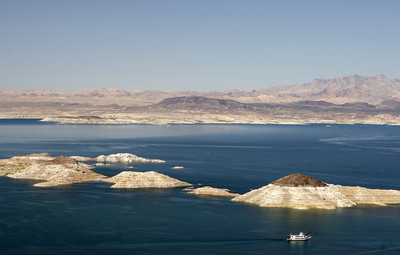Hey Las Vegas, it’s the water
In the past year, the city of Las Vegas has won awards for its alternative vehicle fleet and environmentally conscious building designs.
It has adopted a sustainability policy and backed a new green construction standard.
The metro area was recognized as having relatively low greenhouse gas emissions.
But a recent survey of the nation's 50 largest metro areas ranked the Las Vegas Valley near the bottom of the pack for sustainability.
In fact, Las Vegas dropped 20 places from where the same survey put it in 2006.
The difference?
Water.
The 2006 survey by SustainLane put Las Vegas in 27th place. The 2008 survey put the area 47th overall.
One of the reasons for the drop in ranking was that water supply and water quality were included as considerations this year, said James Elsen, SustainLane's president and CEO.
"There are challenges based on where a city is," Elsen said. "And we're looking at decreasing snowpacks globally. We're looking at water tables that are dropping every year. We're looking at less rain."
The study does give credit for the work that's been done here, which includes aggressive programs to conserve water and find new water sources.
"It's a ranking of peers, so it is possible that Las Vegas could improve against itself but still drop because they're improving more slowly," Elsen said.
Almost all the desert cities in the survey were affected by the inclusion of water supply data. Albuquerque, N.M., improved one spot overall, but Tucson, Ariz., went down two. Mesa, Ariz., was down three to last place. El Paso, Texas, dropped seven spots, and Phoenix was down 10.
All the desert cities except El Paso were in the bottom 10 in the water supply category.
That category looked at the distance from the primary water source, dependence on snowpack, drought levels, population and per capita water use.
Las Vegas gets almost all of its water from the Colorado River, which is fed by melting snow in the Rocky Mountains and currently is in the worst drought on record.
Officials are aware that the valley needs to diversify water sources and are working on piping in groundwater from the north, said Scott Huntley, spokesman for the Southern Nevada Water Authority.
"We've been making that case," he said. "That is a situation that we are very much trying to address."
Conservation efforts such as lawn replacement also have come a long way.
Southern Nevada used 15 billion fewer gallons of water last year than in 2002, despite adding 400,000 residents and hosting millions of tourists, according to the water authority.
In the mid-1990s, residents used about 350 gallons per person per day; last year, that number was 255 gallons, and it's expected to drop this year.
Las Vegas Mayor Oscar Goodman said he was pleased with local environmental efforts, no matter what the survey said.
"I slept soundly, even having seen these results," he said. "I don't put any weight on these kinds of studies.
"As far as smart water practices, our conservation is about as good as it gets. We're using less water now than we did before, even with the population growth."
Portland, Ore., again topped the rankings, followed by San Francisco, Seattle, Chicago and New York City.
Joining Las Vegas at the bottom of the list were Virginia Beach, Va.; Memphis, Tenn.; Tulsa, Okla.; Oklahoma City, Okla.; and Mesa.
The study uses data from government sources and non-governmental organizations to analyze cities in 16 categories.
It was presented at the Sustainable Cities and Communities Conference in Geneva this month. Japan has adopted the group's methodology to analyze its cities.
Contact reporter Alan Choate at achoate@reviewjournal.com or 702-229-6435.
ON THE WEB SustainLane surveyANOTHER TREE GROWS IN LV With minor fanfare, city of Las Vegas officials added another tree to the City Hall grounds Monday to call attention to a new urban forestry program. It was the first of six planned events. The program is aimed at doubling the average tree canopy coverage in Las Vegas to 18 percent by 2035. "We're having our first tree planting at the City Hall campus, which is a great idea because we're moving the City Hall campus," Mayor Oscar Goodman said dryly. "It's amazing the way the city does business." Adding to his grief, the tree that was planted is an Arizona ash: "There's something wrong with every aspect of this!" Goodman quipped. Then he said he was only joking, and he pointed out what proponents say about leafy benefits: increased shade lowers street-level temperatures, trees filter the air, and they make neighborhoods more pleasant and increase property values. The eight trees highlighted for the program are listed as low to moderate water users. The other tree-planting events are: • Oct. 16: 11 a.m. at Ethel Pearson Park, 451 W. Washington Ave. • Oct. 17: 3:45 p.m. at All American Park, 1551 S. Buffalo Drive. • Oct. 21: 3:30 p.m. at Mountain Ridge Park, 7151 Oso Blanca Road. • Oct. 22: 11 a.m. at Doc Romeo Park, 7400 Peak Drive. • Oct. 23: 10 a.m. at Fire Fighters Memorial Park, 6401 W. Oakey Blvd. REVIEW-JOURNAL


















